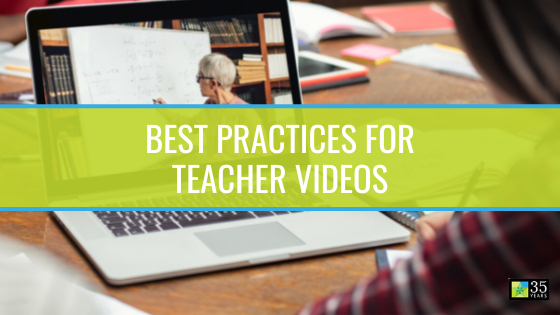[vc_row][vc_column][vc_column_text]
Best Practices For Teacher Videos
School districts are embracing video creation for their teachers and students, giving educators the power of technology to deliver better lesson content. Students respond well to video lessons, especially if they are available on demand. With an inventory of class videos available, students can perform research, answer homework questions, and improve their understanding wherever and whenever. The goal for teachers is to create videos that teach students in an engaging manner. However, that's not always as easy as it sounds. Technology doesn't provide the same kind of feedback that students do, and teaching in front of a camera requires an adjustment period. However, with the right video solutions in place, your teachers will be more comfortable and more effective - and produce better videos as a result.[/vc_column_text][vc_column_text]How to Capture Better Video in the Classroom
Good instructional videos start with good video capturing. If the room is too dark, if the room's acoustics are bad, or if the instructor isn't well framed, the audience will be distracted instead of paying attention to important information. There are a few simple tools that can overcome these production issues, though. For example:- Need better lighting? - There are numerous inexpensive products that can add a bit more lighting to your videos. You don't need professional-level lighting to set up teaching videos, and most solutions are compact enough to fit on a desk or nearby shelf. Ring lights and light cubes are popular options, and many can mount to a laptop for easier positioning.
- Need better framing? - Teachers need to stay in frame for students to maintain their focus on the video. To minimize framing fuss, add a PTZ (pan-tilt-zoom) camera for video capturing. An automated PTZ camera will follow the instructor as they move around the room, ensuring they remain in sight at all times. This is a good choice for teachers who record lessons they're delivering to in-class students.
- Need better audio? - Clear audio is also essential for lesson delivery, and teachers can either use a worn microphone or utilize the microphone built into an interactive display. In both cases, the teacher will be easily heard over any ambient noise.
A Couple of Solutions That Make Teaching Videos More Interesting
The above solutions will work for most traditional lectures, but what if you want to bring in some visually heavy concepts or a lot of notes? Ideally, you'd have a way to present text, images, and ideas clearly through the video. This is a challenge for teachers who rely on a traditional whiteboard because those don't show up well on video. Instead, consider one of these solutions to better integrate annotating and media into your teachers' video lessons:- Interactive flat panels and whiteboarding - With an interactive flat panel like the Clevertouch, teachers can record a whiteboarding session and audio at the same time. The instructor annotates on the board while speaking, as if they were using a physical whiteboard during a lesson. Through the Clevertouch, teachers can also bring in images or videos to supplement the lesson visually. When finished, the teacher can upload the video to a secure library for students to review later.
- eGlass - eGlass is made for lesson delivery, utilizing a camera, a transparent dry erase board and a light to function. During operation, the teacher stands behind the board and writes on it normally. The camera records this and outputs it to video. The effect is professional-level and minimalist. Nothing appears in frame except for the instructor and what they write on the transparent board, which isn't visible. The instructor can wear a microphone for audio pickup.
Schools Also Need Secure Video Storage and Management Solutions
So, you've got a deep collection of excellent teaching videos. You followed all the production tips and are using the best technology to craft the best learning experience for every student. The question now is: Where are you going to put those videos? Some schools use YouTube as their video library of choice, but there are issues there. YouTube is open to the world, and it's difficult to monitor activity on the platform. In many ways, it's not the ideal platform for schools. A leading educational alternative is DEVOS, available through Discover Video. DEVOS is a video storage and management solution specifically designed for schools. Some of its features include:- Video distribution to any device - DEVOS can capture video from a variety of sources and deliver that audio to any device, whether it's a desktop, laptop, tablet, or phone. Video can also be delivered to any networked video outputs, like in-class televisions.
- Stream and securely store video content - DEVOS can stream and prerecord videos for later viewing. In both instances, the video will be securely stored in a password-protected library that only staff and students with permission can access.
- Remote, back-end user management - Through DEVOS's cloud-based management platform, IT can create and remove user profiles, and set permissions for each user. That way, only users with the necessary permissions can record, publish, or access video content.
- Viewer restrictions - DEVOS also allows administrators to restrict access to videos by delivering only to certain devices or requiring viewers to input a password first. This isn't YouTube where privacy is difficult to maintain.
- Teachers and students retain video rights - Schools and those involved in video production retain rights to all video content. Remember that public video platforms like YouTube assume limited rights over the video as soon as it's uploaded to the platform.
- Compatibility with learning management systems - DEVOS can also be integrated with popular learning management systems (LMS). Once done, educators can organize the video they create into multi-part lessons for more effective instruction.



